
Lund is a city in the southern Swedish province of Scania, across the Öresund strait from Copenhagen. The town had 91,940 inhabitants out of a municipal total of 121,510 as of 2018. It is the seat of Lund Municipality, Scania County. The Öresund Region, which includes Lund, is home to more than 4.1 million people.

Helsingborg is a city and the seat of Helsingborg Municipality, Scania (Skåne), Sweden. It is the second-largest city in Scania and ninth-largest in Sweden, with a population of 113,816 (2020). Helsingborg is the central urban area of northwestern Scania and Sweden's closest point to Denmark: the Danish city Helsingør is clearly visible about 4 km (2.5 mi) to the west on the other side of the Øresund. The HH Ferry route across the sound has more than 70 car ferry departures from each harbour every day.

Jakob Benzelius was Archbishop of Uppsala in the Church of Sweden from 1744 to his death.

Jakob Erlandsen was a Danish Archbishop of Lund (1254–1274) and the central character of the first great church conflict in Denmark.

Anders Sunesen was a Danish archbishop of Lund, Scania, from 21 March 1201, at the death of Absalon, to his own death in 1228.
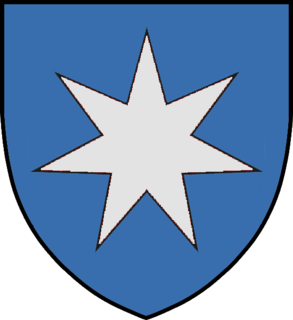
Hvide was a medieval Danish clan, and afterwards in early modern era a Danish noble surname of presumably one surviving branch of leaders of that clan. Before the 16th century it was not used as a surname. It signified the color white.

Scania, also known by its native name of Skåne, is the southernmost of the historical provinces (landskap) of Sweden. Located in the south tip of the geographical region of Götaland, the province is roughly conterminous with Skåne County, created in 1997. Like the other former provinces of Sweden, Scania still features in colloquial speech and in cultural references, and can therefore not be regarded as an archaic concept. Within Scania there are 33 municipalities that are autonomous within the Skåne Regional Council. Scania's largest city, Malmö, is the third-largest city in Sweden, as well as the fifth-largest in Scandinavia.

Dalby Church, sometimes also called the Church of the Holy Cross in Dalby is a church in Dalby, Lund Municipality in the Swedish province of Scania. It is one of the oldest churches in Sweden. When it was built Dalby was part of Denmark, and the church was commissioned by King Sweyn II of Denmark. It was constructed during the second half of the 11th century. For six years, it served as the seat of a bishop, before the diocese was merged with the Diocese of Lund nearby. The church was built with inspiration from Hildesheim Cathedral, and masons from Hildesheim appear to have worked on its construction site.

The Roman-Catholic Diocese of Roskilde was a diocese within the Roman-Catholic Church which was established in Denmark some time before 1022 and lasted until the Lutheran Reformation.

Majestatis was a Romanesque stone sculptor and the creator of several richly decorated baptismal fonts mainly in Scania and on Gotland.
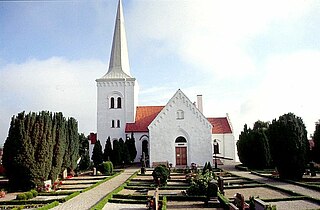
Anderslöv Church is a medieval Lutheran church built in the Romanesque style. Located in the village of Anderslöv, some 11 km (7 mi) southeast of Svedala in southern Sweden, it belongs to the Diocese of Lund. The church is noted for the medieval paintings which decorate its vaulted ceiling.

Sofia Albertina Church is the second and current church in Landskrona, Scania, Sweden. Belonging to the Landskrona Parish of the Church of Sweden, it was inaugurated in 1788 and fully completed in 1816. It is considered a rare church building, in the respect that it has two towers without being a Bishop's church. The church was originally designed by Carl Hårleman, as perhaps his last greater task. Hårleman died in 1753, the same year as the old church was demolished. Smaller changes to Hårlemans original may have been done.
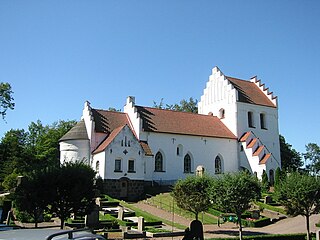
Sireköpinge Church is a medieval Lutheran church east of Landskrona in the province of Scania, Sweden. It belongs to the Diocese of Lund.
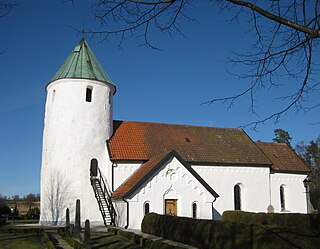
Hammarlunda Church is a medieval Lutheran church in the province of Scania, Sweden. It belongs to the Diocese of Lund.
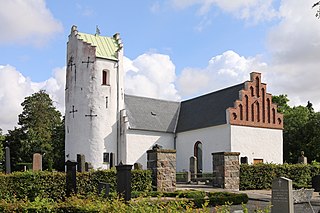
Hammarlöv Church is a medieval Lutheran church in the province of Scania, Sweden. It belongs to the Diocese of Lund.

Events from the year 1772 in Sweden
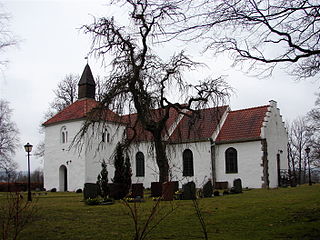
Stehag Church is a medieval church in Stehag, Scania, Sweden. It belongs to the Church of Sweden. It contains Romanesque church murals with royal donor portraits.
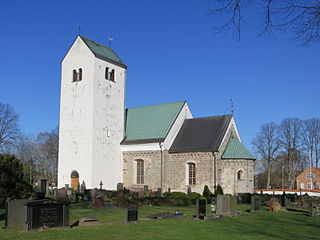
Vä Church, sometimes also called Saint Mary's Church in Vä is a well-preserved Romanesque church in Vä, in the southern Swedish province of Scania. It belongs to the Church of Sweden and is a listed building. It was built in the early 12th century, at a time when Scania was part of Denmark. The building was commissioned by a member of the Danish royal family, probably Queen Margaret Fredkulla. The church originally consisted of a nave, a chancel with an apse and two western towers. Quite soon after being finished, it was donated to Premonstratensian monks who used it as the church of their monastery until 1213. It simultaneously functioned as the parish church of Vä. At the end of the Middle Ages, a third tower was built, and in 1593 the building was enlarged. At the beginning of the 19th century, the western towers were demolished. A major restoration was carried out in the 1960s.

Sven Lagerbring was a Swedish professor and historian. He has been described as "the first Swedish historian in the modern sense."



















